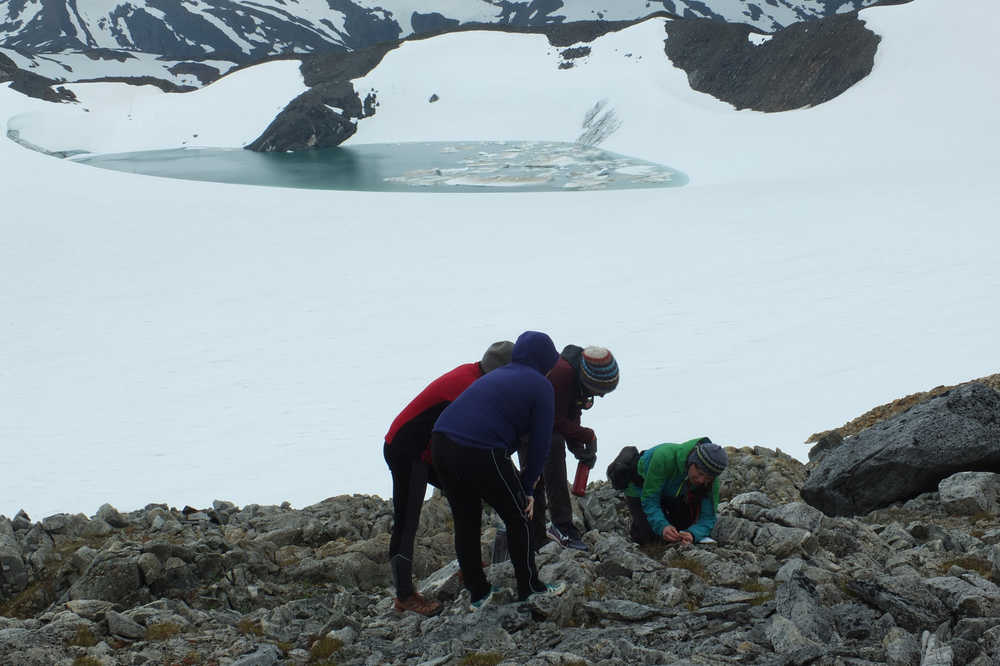JUNEAU ICEFIELD, CAMP 17 — At the Juneau Icefield Research Program’s Camp 17 this week, 32 students — and more faculty — got comfortable on skis, started ecological surveys, and settled in after the day-long hike and a 4,000 foot elevation gain from Lemon Creek Trail.
JIRP, started by glaciologist Maynard “Mal” Miller in 1946, got its first students in 1948 and conducts one of the longest-running mass balance surveys of glaciers in the world. Mass balance measures snow accumulation at the top of glaciers, not just changes at the bottom of them, and is essential data for climate change. A summer on the icefield also gives students from around the world a chance to dip into fieldwork in a variety of ice-bound sciences.
“I’m leaning toward Arctic ecology, and this sounded like a really cool place to (focus on that),” said New Hampshire college student Eric Van Dam. “It’s a cool blend of adventure and science.”
Incoming high school senior Laurel Rand-Lewis is from Los Angeles. She hopes to figure out if scientific fieldwork is something she might want to pursue, career-wise.
“For me, it’s just getting out into the field, and getting the experience,” she said.
Wisconsin college student Ella Keenan is in it for the adventure.
“I’m looking forward to skiing across the icefield and starting our projects,” she said.
Polly Bass is a former University of Alaska Anchorage professor now working with the United States Department of Agriculture; Tuesday afternoon, she was giving Van Dam, Rand-Lewis, and Keenan an introduction to alpine vegetation, like saxifrage. She did research for her PhD on the vegetation of nunataks — rock outcroppings or exposed ridges on or at the edge of glaciers and icefields — and first came to JIRP 17 years ago, as a student.
“I really value the program and … I’ve seen what it does for people, and I know how it inspired me and exposed me to all these different fields of research,” Bass said. “I learned the expedition ethic, and I learned about field science and how important it is.”
JIRP Program Manager Erin Whitney said instead of one academic lead faculty member, JIRP has moved to an “academic council” of five core faculty members who will each be on the icefield for about two weeks, overlapping at the beginnings and ends of their stays.
“It’s our answer to the modern realities of life and science, where it’s very hard to find someone who can spend an entire eight or nine weeks in the field,” she said.
That also makes for a variety of expertise, she said.
Core faculty this year are Allen Pope, Seth Campbell, Shad O’Neel, Matt Beedle, and Whitney. Other, visiting faculty members, like Bass, will spend shorter periods of time with the students.
JIRP’s mass balance survey is the second longest in the world, Whitney said.
In addition to that annual survey, there are five other fields in which students can focus their summer research — GPS surveys to assess the moment and strain of the glaciers, radar studies of different layers in the glaciers’ depths, isotope analysis of snow samples and a look at how isotopes vary in different locations (isotopes are atoms with more or fewer neutrons than normal), an ecological survey of nunatak vegetation, and a study of how reflective and white some areas of the icefield are, which affects how quickly they melt.
They’ll read research papers on different project areas, and then narrow down their interest.
“All the students will have a chance to be introduced to all the project areas in the first couple of weeks,” Whitney said.
Newt Krumdieck, now operations manager for JIRP and camp manager for Camp 17, is another staff member who got his start as a student. This is his sixth year at JIRP.
Much of the students’ time at Camp 17 is intended to ensure their experience on the icefield is as safe as it can be, he said.
“We really focus on safety training here,” he said. “(Today is) some of their first time on skis. We really work hard on ski training, as well as glacier travel basics, rope travel, crevasse rescue … we really make sure that everyone has a really solid foundation to go off of.”
They’ll leave Camp 17 and start a traverse of the Juneau Icefield around July 11, finishing around a month later at Atlin Lake in British Columbia.
“It’s an incredible, life-changing program, and it’s formative for so many people in so many ways,” Whitney said. “Those of us who are involved in it absolutely love it. We’re excited to inspire a new class of students and we would love to provide more opportunities for Juneau to learn about our goals, and our mission, and the fun we have up there.”
As part of that — and as a way to recruit more Alaskan students in future groups — Juneau-ite Deb Gregoire, JIRP’s new program coordinator, hopes to give Juneau-based talks and outreach about the program throughout the upcoming year.
At the end of the season, JIRPers will make presentations on their research both in Atlin and in Juneau. Juneau’s talk is tentatively scheduled for August 17, Whitney said, with a time and place to be announced.

